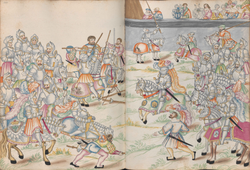|
|
You are not currently logged in. Are you accessing the unsecure (http) portal? Click here to switch to the secure portal. |
Difference between revisions of "Wiktenauer:Main page/Featured"
(Undo revision 70660 by Michael Chidester (talk)) |
|||
| Line 33: | Line 33: | ||
The oldest manuscript in the ''Blume des Kampfes'' group is the [[Die Blume des Kampfes (Cod.5278)|Cod. 5278]], which dates to the late 1420s and contains only simple line drawings somewhat reminiscent of the art of Fiore de'i Liberi, though lacking many signature characteristics such as garters and crowns and generally less organized than the Friulian master's work. The second entry was completed in ca. 1500 by [[Ludwig VI von Eyb]], and while contains a significant degree of overlap with the 5278, both manuscripts also have a wealth of unique content. While the artwork, though colored, is of similar quality, Eyb's treatise improves on its predecessor by including detailed German descriptions of the devices in most of its sections. Whether this text was authored by Eyb or present in the sources upon which he based his work cannot currently be determined. | The oldest manuscript in the ''Blume des Kampfes'' group is the [[Die Blume des Kampfes (Cod.5278)|Cod. 5278]], which dates to the late 1420s and contains only simple line drawings somewhat reminiscent of the art of Fiore de'i Liberi, though lacking many signature characteristics such as garters and crowns and generally less organized than the Friulian master's work. The second entry was completed in ca. 1500 by [[Ludwig VI von Eyb]], and while contains a significant degree of overlap with the 5278, both manuscripts also have a wealth of unique content. While the artwork, though colored, is of similar quality, Eyb's treatise improves on its predecessor by including detailed German descriptions of the devices in most of its sections. Whether this text was authored by Eyb or present in the sources upon which he based his work cannot currently be determined. | ||
| − | |||
| − | |||
| − | |||
| − | |||
([[Die Blume des Kampfes|Read more]]...) | ([[Die Blume des Kampfes|Read more]]...) | ||
Revision as of 17:46, 14 December 2014
| “Die Blume des Kampfes” | |
|---|---|
| The Flower of Battle | |

| |
| Author(s) |
|
| Ascribed to |
|
| Illustrated by | Unknown |
| Date | before 1420s |
| Genre | |
| Language | Early New High German |
| State of Existence | Original hypothetical; multiple incomplete copies exist |
| Manuscript(s) |
|
| Concordance by | Michael Chidester |
Die Blume des Kampfes (“The Flower of Battle”) is a nickname given to a group of three German manuscripts that share a common technical syllabus and set of illustrations. It might possibly be based on the tradition of 14th century Italian master Fiore de'i Liberi, from whose treatise Fior di Battaglia it derives its nickname, given that his works include considerable technical overlap. It is equally likely, though, that they represent an earlier German tradition of which Fiore was himself an initiate. Fiore mentions in his prefaces that he owned books on the art and he also names two older masters in his tradition, Johane Suveno and Nicholai de Toblem; it is possible that either or both of those masters authored texts which inspired both this tradition as well as Fiore's own writings.
The oldest manuscript in the Blume des Kampfes group is the Cod. 5278, which dates to the late 1420s and contains only simple line drawings somewhat reminiscent of the art of Fiore de'i Liberi, though lacking many signature characteristics such as garters and crowns and generally less organized than the Friulian master's work. The second entry was completed in ca. 1500 by Ludwig VI von Eyb, and while contains a significant degree of overlap with the 5278, both manuscripts also have a wealth of unique content. While the artwork, though colored, is of similar quality, Eyb's treatise improves on its predecessor by including detailed German descriptions of the devices in most of its sections. Whether this text was authored by Eyb or present in the sources upon which he based his work cannot currently be determined.
(Read more...)
